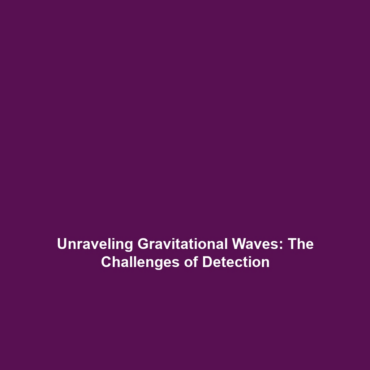Challenges in Detection: Why Detecting Gravitational Waves is Difficult
Introduction
Detecting gravitational waves presents one of the most prominent challenges in modern astrophysics. These ripples in spacetime, predicted by Einstein’s general theory of relativity, carry vital information about cataclysmic cosmic events such as black hole mergers and neutron star collisions. Despite significant advancements, such as the LIGO and Virgo collaborations, the subtle nature of gravitational waves makes them incredibly difficult to detect. Understanding the challenges of detecting these waves is essential for the advancement of gravitational wave astronomy.
Key Concepts
Understanding Gravitational Waves
Gravitational waves are produced by the acceleration of massive objects, creating disturbances in the fabric of spacetime. They propagate at the speed of light and can be detected only when they produce minuscule changes in distance, often on the order of a thousandth of the diameter of a proton. Key concepts related to the detection of gravitational waves include:
- Interferometry: The primary method used to detect gravitational waves involves the use of laser interferometers, where beams of light are split and then recombined, allowing scientists to measure minute changes in distance.
- Signal-to-Noise Ratio: The challenge of distinguishing gravitational wave signals from background noise is a critical aspect of detection.
- Data Analysis Techniques: Advanced algorithms and machine learning techniques integrate vast amounts of data collected to find potential gravitational wave signatures.
Applications and Real-World Uses
The detection of gravitational waves has several crucial applications in various fields, providing insight into both the universe’s workings and potential technologies. Examples include:
- Astrophysics Research: Understanding the universe’s fundamental laws and the life cycles of astronomical objects.
- Cosmology: Using gravitational waves to map the expansion of the universe and refine models of cosmological phenomena.
- Testing General Relativity: Experimental verification of Einstein’s theories through observations of gravitational waves.
Current Challenges
Despite advancements, several challenges remain in the field of gravitational wave detection:
- Sensitivity Limits: Current detectors are limited in their sensitivity, restricting the range at which gravitational waves can be detected.
- Environmental Noise: External factors such as seismic activity and human-made vibrations can interfere with sensitive measurements.
- Data Overload: The enormous volume of data produced during observations presents challenges in data analysis and signal identification.
Future Research and Innovations
Looking ahead, researchers are focused on innovations that may enhance the detection of gravitational waves. Notable areas of future research include:
- Advanced Detectors: Next-generation detectors like the Einstein Telescope and Cosmic Explorer promise higher sensitivity and broader frequency ranges.
- Space-Based Observatories: Missions such as LISA (Laser Interferometer Space Antenna) aim to detect lower-frequency gravitational waves from space.
- Data Analysis Techniques: Incorporating machine learning and artificial intelligence to improve data processing and signal recognition.
Conclusion
Detecting gravitational waves is fraught with challenges, from technological limitations to data-centric issues. However, resolving these challenges is vital for advancing our understanding of the universe and enhancing gravitational wave astronomy. Continued investments in research and innovative technologies will not only improve our detection capabilities but also open new frontiers in astrophysical phenomena. For further reading, explore our articles on the future of astrophysics and gravitational wave applications.
